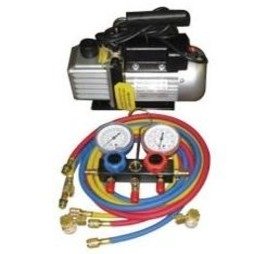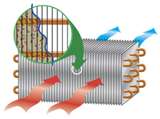
Many mechanics take short cuts when working on car ac. The following is my opinion on how systems should be recharged.
Before recharging auto air conditioning systems it’s recommended to remove any air and moisture from it before adding a fresh charge. This does require a special tool known as an evacuation pump.
This tool can cost a couple hundred bucks although they make some inexpensive ones that take longer to work. This expense can be far less then replacing damaged components as a result of air and moisture.
Pulling a deep vacuum of between 25 and 30 inches of mercury on the system and holding it for no less then 15 minutes is the proper evacuation procedure. If you decide to skip this step your air conditioning may work after recharging, but the question is for how long.
Air in the system restricts the refrigerants ability to change its state from a gas to liquid and this is what can cause AC pressure problems. When the pressure is out of wack it lowers the overall cooling efficiency of the system.
Moisture on the other hand can cause freeze ups and also restrict the refrigerant flow. This moisture can also form an acid when mixed with refrigerant.
This will cause corrosion to form inside the system. An AC vacuum pump connected to a manifold gauge set will remove all of this air and moisture from an empty system.
Unfortunately, you must recover the remaining Freon from the air conditioning before you pull a vacuum. More details about why and how auto air works are available from the article links below. For now lets move onto the problems and procedures with recharging.
Car AC Recharging
Refilling the system with refrigerant is done through the service ports. Using a charging station refrigerant can be pushed into both the low side, and high side when the AC compressor is not running.
If your installing cans of Freon and have pulled a vacuum this reserve negative pressure might be able to suck a full charge out of the individual cans with the engine off. This depends on the capacity.
When the system is operating refrigerant is only charged on the low side service port. If you connect a small can of Freon to the high side, with the engine running and AC on the can might explode from high pressures pushing into it.
Certainly no Freon will flow from the small can into the high side with the compressor operating. The low side is nicknamed the suction side, because it will pull refrigerant out of the can when the compressor clutch is engaged.
The importance of the correct amount of Freon added during the charging procedure is extremely important. In fact, to achieve the correct output temperature you need to be within a few ounces.
I need to state this again. The efficient operation of the air-conditioning depends greatly on the correct amount of refrigerant installed in the system. The type and total capacity is usually marked on an engine compartment sticker in pounds and ounces here in the United States.
A low charge will result in poor cooling under high heat loads due to a lack of reserve refrigerant. This can cause the clutch cycling switch of the compressor to click on and off.
This cycling of the compressor clutch is also a telltale sign that your system is low. You should always connect a manifold gauge set to verify this low-pressure condition.
An overcharge of the AC can also cause inadequate cooling. This is because a high liquid refrigerant level in the condenser decreases it’s efficiency.
If the system is overcharged compressor damage can also occur when and if liquid Refrigerant enters the compressor. This is because a liquid can not be compressed and major damage is usually the result.
Once again an ac gauge set connected to the high and low side will show this. If too much Freon is in the system you get higher than normal pressure readings.
Basic Auto AC Diagnosis and Repair
The normal pressure readings on a vehicle’s air-conditioning system will vary with the outside temperature. In general the higher the ambient temperature and humidity the higher the readings.
A good rule of thumb is to have between 30 and 45 PSI on the low side confirmed with a reliable gauge. And a reading of 125 psi to 200 psi on the high side.
Again this will vary with the amount of charge in the system and with the outside temperature. If you should connect your manifold gauges and see readings that are out of this range then your air-conditioning system is probably not cooling well.
Online service manuals can provide you with diagnostic tree charts if these hi or low side pressure readings are out of range. If components need to be replaced these same manuals provide step by step repair procedures.

Just as an example, if your high side pressure is over 250. This is an indication of a problem unless it’s over 100 degrees outside. If I see this reading I will look at the condenser fan operation.
The reason for this is the condenser fan removes heat from the high side of the system. If this fan is not blowing across the condenser, the refrigerant will have extremely high temperatures.
As we learned before, the higher the temperature, the higher the pressure. If the fan is blowing then I look for blockage or debris clogging the tiny aluminum fins. This can also cause lack of air flow across the unit.
This is why I recommend understanding how a car air-conditioning works before attempting diagnosis or repair. Even if you’re taking the vehicle in for service it is still worth learning about. Share or bookmark this car ac page. Then explore some more information on this subject.
This next link will take you to a good place to start. This is the first page of my automotive air conditioning section.
If your car ac system still has the old style refrigerant this next link talks about how to replace the old r12 freon.
Learn more about what is covered on this car repair website on The YouFixCars.com Homepage.
Car ac systems are dangerous to work on. When in doubt leave it for the professionals. If you are going to perform DIY repairs please review this next page for ac safety tips.

